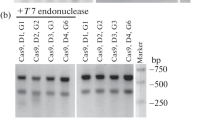Abstract
The isolation of a human cDNA encoding the multifunctional protein containing GAR synthetase, AIR synthetase, and GAR transformylase by functional complementation of purine auxotrophy in yeast has been reported. Chinese hamster ovary (CHO) cell mutant purine auxotrophs deficient in GAR synthetase (Ade−C) or AIR synthetase plus GAR transformylase (Ade−G) activities were transfected with this human GART cDNA subcloned into a mammalian expression vector. This restored 49–140% of the activities of GAR synthetase, AIR synthetase, and GAR transformylase in transfected cells when compared to wild-type CHO K1 parental cells. Study of one stably expressing transfectant, AdeC2, revealed that the human GART cDNA was incorporated into the CHO genome. The enzyme activities appear to be associated with an expressed protein of 110 kDa, very similar to that of purified human GART trifunctional enzyme. The Ade−C mutant shows reduced amounts of GART mRNA compared to CHO K1 and a protein of apparently reduced size, results consistent with the purine requirement and enzyme deficiency observed in the mutant. These experiments provide definitive evidence that the human GART cDNA encodes and can direct the production of active human GART trifunctional protein in mammalian cells. They also provide important evidence that the Ade−C and Ade−G mutants of CHO cells are defective in this gene.
Similar content being viewed by others
Literature cited
Henikoff, S., Tatchell, K., Hall, B.D., and Nasmyth, K.A. (1981).Nature (London) 28933–37.
Henikoff, S., Keene, M.A., Sloan, J.S., Bleskan, J., Hards, R., and Patterson, D. (1986).Proc. Natl. Acad. Sci. U.S.A. 83720–724.
Henikoff, S., and Eghtedarzadeh, M.K. (1987).Genetics 117711–725.
Henikoff, S. (1986).J. Mol. Biol. 190519–528.
White, J.H., Lusnak, K., and Fogel, S. (1985).Nature (London) 315350–352.
Daubner, S.C., Schrimsher, J.L., Schendel, J., Young, M., Henikoff, S., Patterson, D., Stubbe, J., and Benkovic, S.J. (1985).Biochemistry 247059–7062.
Daubner, S.C., Young, M., Sammons, R.D., Courtney, L.F., and Benkovic, S.J. (1986).Biochemistry 252951–2957.
Schild, D., Brake, A.J., Kiefer, M.C., Young, D., and Barr, P.J. (1990).Proc. Natl. Acad. Sci. U.S.A. 872916–2920.
Aimi, J., Qui, H., Williams, J., Zalkin, H., and Dixon, J.E. (1989).Nucleic Acids Res. 186665–6672.
Hards, R.G., Benkovic, S.J., Van Keuren, M.L., Graw, S.L., Drabkin, H.A., and Patterson, D. (1986).Am. J. Hum. Genet. 39179–185.
Patterson, D., Graw, S., and Jones, C. (1981).Proc. Natl. Acad. Sci. U.S.A. 78405–409.
Pant, S.S., Moser, H.W., and Krane, S.M. (1968).J. Clin. Endocrinol. 28472–477.
Patterson, D., Jones, C., Scoggin, C., Miller, Y.E., and Graw, S. (1982).Ann. N.Y. Acad. Sci. 39669–81.
Ellis, L., Clauser, E., Morgan, D.O., Edery, M., Roth, R.A., and Rutter, W.J. (1986).Cell 45721–732.
Southern, P.J., and Berg, P. (1982).J. Mol. Appl. Genet. 1327–341.
Maniatis, T., Fritsch, E.F., and Sambrook, H.J. (1982). InMolecular Cloning: A Laboratory Manual, (Cold Spring Harbor Laboratory, Cold Spring Harbor, New York).
Southern, E.M. (1975).J. Mol. Biol. 98503–517.
Feinberg, A.P., and Vogelstein, B. (1983).Anal. Biochem. 1326–13.
Cathala, G., Savouret, J.F., Mendez, B., West, B.L., Karin, M., Martial, J.A., and Baxter, J.D. (1983).DNA 2329–335.
Thomas, P.S. (1980).Proc. Natl. Acad. Sci. USA 775201–5205.
Chang, F.-H., and Bourne, H.R. (1987).Endocrinology 1211711–1715.
Kleid, D.G., Yansura, D., Small, B., Dowbenko, D., Moore, D.M., Grubman, M.J., McKercher, P.D., Morgan, D.O., Robertson, B.H., and Bachrach, H.L. (1981).Science 2141125–1129.
Laemmli, U.K. (1970).Nature 227680–685.
Lowry, O.H., Rosebrough, N.J., Farr, A.L., and Randall, R.J. (1951).J. Biol. Chem. 193265–275.
Salinovich, O., and Montelaro, R.C. (1986).Anal. Biochem. 156341–347.
Chang, F.-H., and Bourne, H.R. (1989).J. Biol. Chem. 2645352–5357.
Hards, R.G., and Patterson, D. (1986).Enzyme 35117–126.
Young, M., Sammons, R.D., Mueller, W.T., and Benkovic, S.J. (1984).Biochemistry 233979–3986.
Scoggin, C.H., Bleskan, J., Davidson, J.N., and Patterson, D. (1980).Clin. Res. 28:31A.
Lai, L.W., Hart, I., and Patterson, D. (1991).Genomics 9322–328.
Hards, R.G., and Patterson, D. (1986).Mech. Age. Devel. 665–70.
Bradley, C.M., Patterson, D., and Robinson, A. (1988).Trisomy 21 141–51.
Bartley, J.A., and Epstein, C.J. (1980).Biochem. Biophys. Res. Commun. 931286–1289.
Davidson, J.N., and Patterson, D. (1979).Proc. Natl. Acad. Sci. U.S.A. 761731–1735.
Patterson, D., Meinkoth, J., Wahl, G., Vannais, D., Niswander, L., and Davidson, J. (1985).Genetics 110538–539.
Patterson, D., Barton, J., Lai, L.W., and Chang, F.H. (1990). Vth International Congress, Inborn Errors of Metabolism, Pacific Grove, California, June 1–5, p. P52.
Henikoff, S. (1987).Bioessays 68–13.
Davidson, J.N., and Patterson, D. (1984).DNA 378.
Author information
Authors and Affiliations
Rights and permissions
About this article
Cite this article
Chang, FH., Barnes, T.S., Schild, D. et al. Expression of a human cDNA encoding a protein containing GAR synthetase, AIR synthetase, and GAR transformylase corrects the defects in mutant Chinese hamster ovary cells lacking these activities. Somat Cell Mol Genet 17, 411–420 (1991). https://doi.org/10.1007/BF01233066
Received:
Issue Date:
DOI: https://doi.org/10.1007/BF01233066




